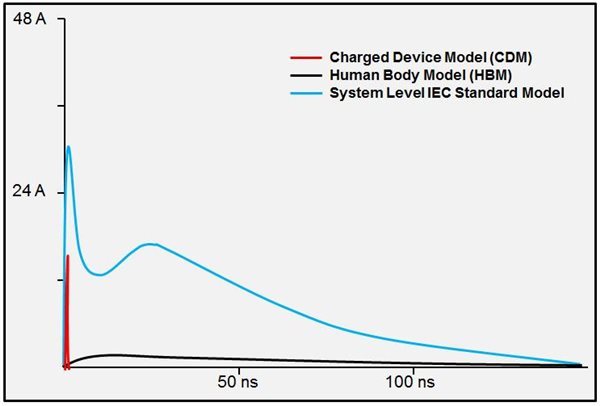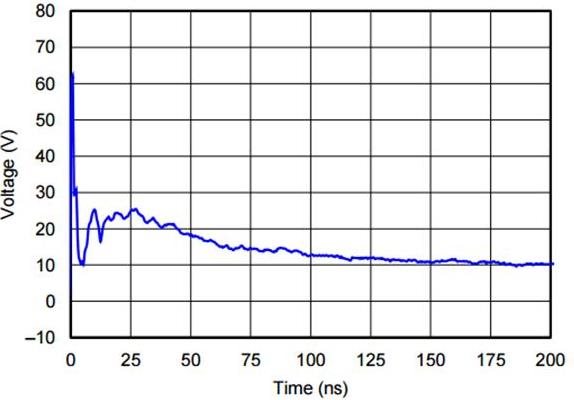As electricity travels from generation stations to utility customers, end-equipment in the smart energy grid ensures the successful delivery of electricity to consumers and accurate monitoring of consumer consumption for billing. Energy-grid equipment must be resistant to electrical disturbances such as electrical overstress (EOS) from lightning strikes, disturbances or transients in the attached power grid, and electrostatic discharge (ESD) damage caused by technicians servicing these devices or end users.
These electrical disturbances can cause damage to or temporarily alter the operation of some semiconductor components in energy-grid equipment. When you look at the data sheets for these semiconductor devices, you’ll see human-body model (HBM) and charged-device model (CDM) ESD ratings. The HBM rating provides an indication of the chip’s resilience to ESD damage from human handling, while the CDM rating is related to the chip’s ability to resist ESD damage during automated manufacturing. Neither HBM nor CDM device ratings address the need for overall system transient immunity. So the International Electrotechnical Commission (IEC) released system-level transient immunity standards to ensure that complete systems, like smart meters or data concentrators, would be protected against EOS. These system-level transient immunity standards include:
- IEC 61000-4-2: electrostatic discharge immunity test.
- IEC 61000-4-4: electrical fast transient (EFT) immunity test.
- IEC 61000-4-5: surge immunity test.
Compared to CDM and HBM, the IEC 61000-4-2 standard tests to higher levels of ESD energy; see Figure 1. The IEC 61000-4-4 and IEC 61000-4-5 standards provide an extra layer of transient protection to ensure a robust final product.
Figure 1: ESD test comparison
Transient voltage suppressors
There are two types of transient voltage suppressor (TVS) diodes that can deliver IEC 61000-4-x system-level electrical transient protection for smart-grid applications. The first type is a general-purpose/low-capacitance TVS diode. TI’s TPD4E05U06 is a great example of this type of ESD protection solution, with these specifications:
- IEC 61000-4-2 (ESD): 12/15kV (contact/air gap).
- IEC 6100-4-4 (EFT): 80A (5/50ns).
- IEC 61000-4-5 (surge): 2.5A.
As you can see, this type of device offers high levels of ESD and EFT protection but lower levels of surge protection. These devices protect communication interfaces (USB and Ethernet) and subscriber identity module (SIM) card interfaces. Additionally, the devices can protect display and keypads for data concentrators, smart electricity meters, power-quality meters, as well as other types of smart-grid equipment. In smart electricity meters, these devices protect the microcontroller from residual surge energy transferred through the analog front end (AFE). Lastly, these devices can protect against meter tampering where people use ESD-generating equipment to alter the state of electricity meters.
The second type of TVS diode is a surge TVS diode. Surge TVS diodes offer higher levels of surge protection (20A+) in addition to ESD and EFT protection. The capacitance of surge TVS diodes is usually too high for data communication, but they are sometimes used for Ethernet and RS-485 protection. Furthermore, they are often used in power rails and power-line communication modules.
Figure 2 shows the TPD4E05U06 responding to a +8kV ESD event. When the ESD event is over, the TVS diode stops conducting current to ground and the smart-grid end equipment resumes normal operation.
TPD4E05U06 IEC 61000-4-2 clamping voltage, +8kV contact
The new TI Designs Data Concentrator Reference Design is a great example of how to properly implement ESD, EFT and surge protection for all of the communication interfaces in your system. Furthermore, the design provides flexibility and scalability with numerous performance, cost and connectivity options for your data-concentrator designs.
Additional resources:
- To learn more about smart-grids/grid-infrastructures and the various solutions TI offers, see the Grid Infrastructure System Solutions landing page.
- To learn more about TI’s circuit-protection devices, see the ESD protection overview page. This page includes additional information about TI protection product families, an ESD by Interface tab and links to parametric search by clicking View Products.
- Download the ESD Protection Reference Guide.
- To learn more about TVS diodes, test setups and layout, check out these application reports:


